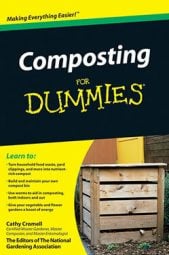In addition to bedding and food, your composting worms need appropriate temperature, moisture, oxygen, and pH levels to thrive. Here are some basics for maintaining a healthy environment for your worms:
Light: Worms don't have eyes, but they're still extremely sensitive to light and move away from bright light if they can. If exposed to bright light for an hour, some worms become paralyzed. Unable to move away, they dry out and die. Put your bin in a dark location, keep a lid on it, or throw a towel or other covering over it to block light.
Temperature: The optimal temperature range for red wigglers is 55–77 degrees Fahrenheit (13–25 degrees Celsius). You can stretch those limits to 50–84 degrees Fahrenheit (10–29 degrees Celsius), but they may not process as much organic matter or reproduce as vigorously.
Moisture: Maintaining moist bedding is crucial. Worms must remain in a moist, humid environment at all times, or they will die. Worm bedding should be 60 to 85 percent moisture. Depending on what types of food scraps you supply, the bedding may remain moist. If necessary, add moisture by misting with a water spray bottle or sprinkling drops of water across the bed periodically.
On the other hand, don't let the bin become a swamp. Wet conditions turn the bin into a smelly anaerobic composting system.
Breathing room: Red wigglers need oxygen to maintain their household as an aerobic (with air), sweet-smelling system. Be careful not to allow bedding to become too wet or to add too much food at once, which may deplete oxygen levels. Once a week or so, aerate the bedding by gently fluffing it up. If you're squeamish about worms, wear rubber gloves or use a big plastic spoon or spatula to gently lift and turn.
pH levels: In nature, worms survive in a range of pH levels, but in the small space of your bin, it's best to keep pH in the range of 6.8 to 7.2.
Does that mean you have to measure pH levels? Not unless you want to. The following food adjustments can help you maintain pH levels that don't jump out of whack:
Limit the amount of citrus scraps to prevent the bin from getting too acidic.
Add crushed eggshells to lower acidity.
Limit the amount of nitrogen-rich materials that rapidly decompose, such as an abundance of coffee grounds. Nitrogen materials release ammonia and increase pH levels.
If you're interested in testing the pH of your worm bin, garden stores and online retailers sell various styles of simple pH testing kits, such as a paper strips, capsules, or meters. Although not always extremely precise, they'll provide you with a troubleshooting guide.

